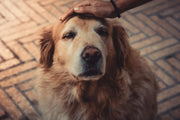
If you’ve ever been petting your dog and felt an unexpected lump under their skin, you’re not alone. Lumps and bumps are among the most common reasons dog owners visit the vet. While many growths are harmless, others can be serious—so knowing when to get veterinary advice is essential. Skin bumps can be due to many different reasons, ranging from skin infections, localized swelling, or allergic reactions to more complicated issues like actual skin masses (benign lumps) and other abnormal growths (malignant growths). Understanding pet lumps and bumps and knowing when to seek veterinary care are key to keeping your pet healthy.

Why Do Dogs Get Lumps?
Lumps (also called masses or growths) can form for many reasons, ranging from simple fat deposits to infections or even cancerous tumors. Some of the most common causes include:
Lipomas (fatty tumors): These are soft, movable lumps under your pet's skin. They a collection of fat cells in one area, usually right under the dog's skin. They are connective tissue tumors in the subcutaneous fat layer of the skin. They’re most common in older or overweight dogs.
Cysts: Fluid-filled lumps that can develop when a hair follicle or gland becomes blocked. They sometimes rupture or leak but are usually non-cancerous. Sebaceous cysts are usually filled with a keratin substance and they occur when oil glands are blocked or damaged.
Abscesses: These painful, warm lumps form when there’s an infection, often from a bite, scratch, puncture wound or even an insect bite. They may ooze pus and need prompt veterinary care. Abscesses need immediate removal or debridement by a veterinary professional.
Warts and skin tags: Small, wart-like growths mostly caused by viruses or simple skin changes. They often appear around the mouth, eyes, or paws, especially in older dogs. Squamous cell carcinomas, a type of skin cancer, can look like warts. This further highlights the need for early detection and veterinary attention.
Mast cell tumors and other cancers: Some lumps are malignant and can spread quickly. Mast cell tumors, for example, may look like harmless lumps and bumps but are actually aggressive cancers that usually present as multiple lumps growing rapidly.
Because lumps can look similar on the surface, it’s nearly impossible to know what you’re dealing with just by looking or touching. That’s why veterinary evaluation is so important.
Lipomas (fatty tumors), lymphoma and Sebaceous Cysts- What's the difference?
Lipomas and sebaceous cysts are two of the most common—and most often confused—types of lumps found on dogs. A lipoma is a benign tumor made up of fat cells. It typically feels soft, smooth, and moves easily under the skin when you press on it. Lipomas are not painful and often grow slowly over months or years.
A sebaceous cyst, on the other hand, is not a tumor at all but a blocked oil gland . These cysts usually feel firmer than lipomas and may have a small central pore. They are fluid filled sacs. They can sometimes rupture, releasing a thick, whitish or cheesy material. While cysts are usually harmless, they can become infected or inflamed and may need to be drained or surgically removed.
It’s also important not to confuse a lipoma with lymphoma. Despite sounding similar, they are entirely different conditions. Lymphoma is a cancer of the lymphatic system, affecting lymph nodes and immune cells. It’s a serious, potentially life-threatening disease that can cause swelling of the lymph nodes (often under the jaw, in front of the shoulders, or behind the knees), lethargy, weight loss, and loss of appetite. Lipomas, by contrast, are localized fatty growths and do not spread throughout the body.

What to Do When You Find a Lump on your dog's skin
-
Don’t panic. Finding a lump doesn’t automatically mean bad news. Many dogs develop harmless lumps and bumps as they age.
-
Make a note of it. Record when you first noticed it, where it is on the body, and what it feels like. A photo or short video can help track changes over time.
-
Check for more. Run your hands over your dog’s entire body to see if there are any other lumps you may have missed.
-
Monitor size and texture. If you notice a lump growing quickly, changing color, becoming firm or ulcerated, or if it’s causing pain or discharge, contact your vet right away.
When to Get Veterinary Advice or Immediate Veterinary Attention
You should always get immediate veterinary attention and the lump checked if you notice any of the following:
-
The lump is growing rapidly or changing shape.
-
It feels hard, fixed, or irregular rather than soft and movable.
-
There is bleeding, discharge, or ulceration. Bleeding lumps or those with discharge may warrant antibiotic treatment due to concurrent bacterial infections and or skin irritation.
-
Your dog is licking, biting, or scratching the area repeatedly.
-
The lump is causing pain or discomfort.
-
Your dog shows signs of systemic illness—such as weight loss, lethargy, loss of appetite, or swollen lymph nodes.
Even if the lump seems harmless, it’s a good idea to have any new growth checked by a vet, especially in senior dogs (over 7 years old) or breeds prone to cancer (such as Boxers, Golden Retrievers, and Labradors). Young dogs tend to have less incidence of cancerous lumps but are not exempt from developing either benign growths or malignant tumors. Pet owners must take any skin lumps seriously at any age.
What Your Vet Will Do to differentiate between a malignant tumor and a benign lumps
Vets diagnose lumps with a physical exam first and may recommend one or more diagnostic tests to identify what the lump is made of. Common procedures include:
Fine needle aspiration (FNA): A quick, minimally invasive test where a small needle is used to collect cells from the lump for microscopic examination.
Biopsy: A small tissue sample is surgically removed and sent to a lab for detailed analysis. This provides a more definitive diagnosis.
Imaging (X-rays or ultrasound): If there are concerns about spread or internal involvement, your vet may use imaging to check deeper tissues or organs.
Based on results, your vet will discuss the best treatment plan and offer varying treatment options. Benign lumps might just need monitoring, while others may require surgical removal or further treatment such as medication, chemotherapy, or radiation treatment if the underlying tissue is found to be malignant tumors.
Can Dog Lumps Be Prevented?
While not all lumps can be prevented, there are steps you can take to help your dog stay healthy:
Maintain a healthy weight. Obesity increases the risk of fatty tumors. Obesity can also complicate surgical removal (increased risk during anesthesia and difficult wound closure due to skin taughtness)
Feed a balanced diet rich in antioxidants and nutrients that support the immune system.
Check your dog regularly. Monthly “nose-to-tail” exams at home help you catch new lumps early.
Keep up with vet checkups. Annual or semi-annual visits are key for early detection, especially in older dogs.
Avoiid prolonged sun exposure especially in hairless breeds like the Chinese Crested or Mexican Hairless dog.

Living With a Dog Who Has Benign tumors
If after a physical examination and testing your vet determines that a lump is benign and doesn’t need surgical removal or fine needle aspiration (FNA)/biopsy, you can still keep an eye on it. Pet owners can measure it occasionally (you can use a ruler or soft measuring tape) and note any changes and accompanying symptoms. Some owners even keep a “lump log” with photos of their dog's skin and growth and dates to make tracking easy. You can also advocate for your pet and urge your vet to take tissue samples if you find new lumps, enlarged lymph nodes or any other change in your pet's health.
Remember that not every lump needs surgery, and not every diagnosis is dire. Many furry friends live long, happy lives with harmless, benign growths. The most important thing is to stay observant of your dog's body and work closely with your veterinarian to get ahead of any cancerous growths. Your pet's health and well-being should always be at the forefront. Also, keep in mind that treatment options not only vary with diagnosis but also by how your pet reacts to each. Some pets may not be candidates for a specific treatment option due to comorbidities, age, and location of the mass. There is no one-size-fits-all treatment for any diagnosis.

Lumps and bumps are common in dogs, especially as they age, but it’s impossible to tell what’s benign or serious without veterinary evaluation. Early detection and testing are the best ways to ensure your dog’s health and peace of mind.




